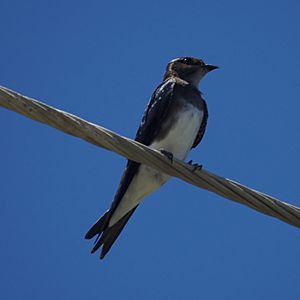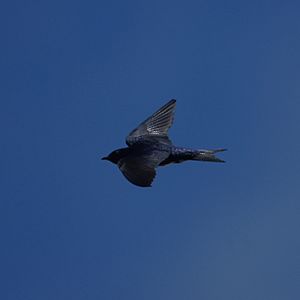Caribbean martin facts for kids
Quick facts for kids Caribbean martin |
|
|---|---|
 |
|
| Conservation status | |
| Scientific classification | |
| Genus: |
Progne
|
| Species: |
dominicensis
|
The Caribbean martin (Progne dominicensis) is a large swallow. It is also known as the white-bellied martin. These birds are related to the purple martin, which is another type of swallow.
Contents
Where Do Caribbean Martins Live?
Caribbean martins live and have their young all over the Caribbean islands. However, you won't find them on Cuba or Isla de la Juventud. In those places, you'll find their close relative, the Cuban martin.
These birds are also related to the Sinaloa martin. Many Caribbean martins migrate (travel) to mainland South America for part of the year. Sometimes, they are even seen in Central America. One Caribbean martin was even spotted in Key West, Florida, a long time ago in 1895!
What Do Caribbean Martins Look Like?
Adult Caribbean martins are about 18.5 centimeters (7.3 inches) long. They have a tail that looks forked, like a "V" shape. Their wings are quite wide. Each bird weighs about 40 grams (1.4 ounces).
Male Caribbean martins are very shiny. Their top feathers are a glossy blue-black color. Their lower belly is a bright white. Female birds and young ones are not as shiny. They have a grey-brown chest and sides, but their lower belly is still white.
How Do Caribbean Martins Behave?
Caribbean martins build their nests in different places. They like to use holes in banks or buildings. They also use old holes that woodpeckers made in trees. They lay about 3 to 6 eggs in their nests.
The parents sit on the eggs for about 15 days. After the eggs hatch, the young birds stay in the nest for another 26 to 27 days. Then they are ready to fly!
Just like purple martins, these birds sometimes have to compete for nesting spots. In cities, they might compete with house sparrows for spaces in buildings. But in the countryside, they often use holes in coconut trees. There, they don't have as much competition with sparrows.
Caribbean martins are social birds. This means they like to be in groups. They catch insects while flying in the air. Their call sounds like a gurgly "chew-chew."
See also
 In Spanish: Golondrina caribeña para niños
In Spanish: Golondrina caribeña para niños




